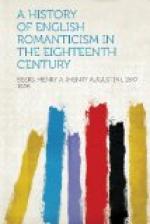“The parterre before which Chatterton declaimed was full of pale, long-haired youths, who firmly believed that there was no other worthy occupation on earth but the making of verses or of pictures—art, as they called it; and who looked upon the bourgeois with a disdain to which the disdain of the Heidelberg or Jena ‘fox’ for the ‘philistine’ hardly approaches. . . As to money, no one thought of it. More than one, as in that assembly of impossible professions which Theodore de Banville describes with so resigned an irony, could have cried without falsehood ‘I am a lyric poet and I live by my profession.’ One who has not passed through that mad, ardent, over-excited but generous epoch, cannot imagine to what a forgetfulness of material existence the intoxication, or, if you prefer, infatuation of art pushed the obscure and fragile victims who would rather have died than renounce their dream. One actually heard in the night the crack of solitary pistols. Judge of the effect produced in such an environment by M. Afred Vigney’s ‘Chatterton’; to which, if you would comprehend it, you must restore the contemporary atmosphere."[31]
[1] Wordsworth, “Resolution and Independence.”
[2] January 1, 1753.
[3] “The Poetical Works of Thos. Chatterton. With an Essay on the Rowley Poems by the Rev. Walter W. Skeat and a Memoir by Edward Bell”; in two volumes. London, 1871, Vol. I. p. xv.
[4] Willcox’s edition of “Chatterton’s Poetical Works,” Cambridge, 1842, Vol. I. p. xxi.
[5] “Memoir by Edward Bell,” p. xxiv.
[6] Cf. ("Battle of Hastings,” i. xx)
“The grey-goose pinion,
that theron was set,
Eftsoons with smoking crimson
blood was wet”
With the lines from “Chevy Chase” (ante, p. 295). To be sure the ballad was widely current before the publication of the “Reliques.”
[7] See ante, p. 237.
[8] Walter Scott quotes this passage in his review of Southey and Cottle’s edition of Chatterton in the Edinburgh Review for April, 1804, and comments as follows: “While Chatterton wrote plain narrative, he imitated with considerable success the dry, concise style of an antique annalist; but when anything required a more dignified or sentimental style, he mounted the fatal and easily recognized car of the son of Fingal.”
[9] Publication begun 1761: 2d edition 1768. Chatterton’s letter was dated March 25 [1769].
[10] See ante, p. 346.
[11] “Poems supposed to have been written at Bristol by Thomas Rowley and others in the fifteenth century. The greatest part now first published from the most authentic copies, with engraved specimens of one of the MSS. To which are added a preface, an introductory account of the several pieces, and a glossary. London: Printed for T. Payne & Son at the Mews Gate. MDCCLXXVII.”
[12] “Observations upon the Poems of Thomas Rowley,” 2 vols. 1781.




